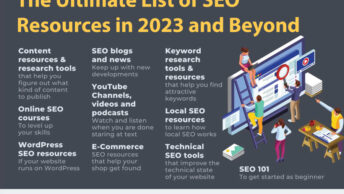
Times have changed since the days of black and white newspaper print and the corner town crier to advertise the news. In those days, marketing was handled in print, in those same newspapers and the commercials that we were forced to watch on the black and white televisions. Ok, maybe not “we” since that really was quite a long time ago!
Somewhere between that point and where we are now, computers became a mainstay. Not only did every household have one, but now it is a case of every person having even multiple computers and smart devices. As a result, the marketing and branding strategies have become digital content strategies and the newspapers are used to line the bottom of the bird cage.
With this new type of marketing, has come a plethora of opportunities. It is like the sky is the limit. Think about it. Decades ago, if you had a typo in your advertisement, you were stuck. If it was printed, that was it. You may have to print what is called a “retraction” in the next issue (saying, “oops, I didn’t mean that”). When the computer age (information age) came upon us, we could quickly going into the web page (even before WordPress!) and change the verbiage and “fix the boo boo.”
In 2012 some pranksters had a little fun with grammar by using PhotoShop on a Tails magazine cover of Rachael Ray. Years ago, you would not have had the opportunity to fix it digitally. Granted, years ago, the prank wouldn’t have happened because the prank is a case of tweaking it with Photoshop (read story here). Note: Interestingly, this same story just went viral again, recently, as if it is “new” news.”
@briandavidearp @GreggDCaruso @chartier True about the comma, but fake: http://t.co/eAxWJp52GU pic.twitter.com/TgVR5qGQho
— Brandon Mathis (@imathis) September 29, 2014
So, what is the downside of branding in this wonderful age of social media? Let me tell you…
- What to Brand and What Not to Brand?
What are you actually branding? Many times the established brick and mortar companies that hire the Harvard grad students understand this already and continue to do what they have been doing for decades, successfully, online. But, with as many start-ups as exist, as well as more and more entrepreneurs (with little or no formal business experience) enter into this category, there is what is called branding confusion. For a slideshare on brand (and brand identity kits), check out this slideshare.
- What is Our Brand?
This one is related to #1. For example, is your brand the “McDonalds” (restaurant) or is it the “hamburger?” So many times, new companies get that confused and they brand the hamburger instead of the restaurant. But, there are cases where the brand of the product is actually ok. That is a decision that the company has to make. If the company plans to create additional products, then they should be branding the company. In fact, really this is what should be branded. But, with every rule, there may also be an exception. The best idea is to meet together as partners of the company and really hash out the challenges and outcomes of the decision(s). You may also want to have surveys and request feedback on your web site, to see what your customers and followers think. Another option is to brand the product as a project, as a part of the _____ (company name) network.
- Corporate Branding Versus Individual Branding.
This is a big one that pops up as a challenge many times. It is something that the companies did not have to wrestle with years ago. Years ago, you could hand out your business card at a cocktail party and people knew that you were so-and-so who worked for such-and-such company in the capacity listed on your business card. There was not a confusion of where the individual starts and stops and where the company starts and stops. Nowadays, the employee’s life may be laid out completely on their Facebook page. This may irritate the company if they feel that the employee’s behavior is not in keeping what they expect. So, what should be done? Should the employee stop living his or her life, stay off Facebook, and become a corporate robot? Or, should the company stop caring about what the individual does and just stick to their own company branding? There are arguments for both. The problem is that the company really is judged, to some extent, by the “brand” that is created by the individual employee(s). This is one of those things that really doesn’t have a black and white answer and must by handled case-by-case.
- What Platform Do I Use?
Now companies have so many choices that they are not sure which one is best. For example, should they have a presence on every social network that exists or only the top x number of platforms? And, what is the definition of the top x platforms? What is considered a list of top social networks for one company may not fit for another company. For example, a financial services company may not find Pinterest to be the top social network for their brand. Then again, if they continuously appear on Bloomberg TV, they may want to feature snaps of their appearances on Pinterest, to gain notoriety (BTW – just a note – You have to get permission and pay fees to Bloomberg to do that.)
This is a case of sitting down and defining what the company does and who the target audience is. Also, the quantity of platforms should be defined according to the resources available to manage the platforms. Then, once you have the quantity, the objectives, the audience definition, you can make a more informed decision of how far to go, when it comes to the social media platforms/networks. Be sure to set up your brand on all of the networks, to establish yourself, but then focus on those that you have decided as a result of the meeting. Remember, there is nothing stopping you from adding to that list later.
- How Do I Know If It Is Successful?
Metrics for social media marketing is very important. As it relate to branding, if you do not have a pulse on what is going on, through metrics and analytics, you will not know if their is any brand confusion or branding issues that need addressing. Managing reputation is very important and this means that you are monitoring your brand. On a very basic level, Google alerts can help. It is very rudimentary and certainly doesn’t catch everything, but it will catch any real explosion or crisis that needs to be handled.
- Finding the Right Person for the Job.
Everyone and their brother probably knows how to do social media marketing. Or, so they say, eh? Actually, there is a difference between understanding social media and understanding social media marketing. The first thing that any branding-conscious company needs to understand is that just because someone says they understand social media marketing doesn’t mean that they truly do. And, even if they are an expert at social media marketing, do they hold the same values as you do? That is important (as noted in the next item) because it is YOUR brand that is affected by their actions.
One of the most basic aspects to check, when receiving job applications or inquiries, is to check the candidates social media profiles. In the companies where I have worked, we hire specialists to do background checks specifically on the social media activity of the candidate. I once had someone apply to be a social media marketing specialist and they basically had zero social media activity. That is a clue that either there is a typo in their application or something isn’t quite right.
Another way to hire a quality person to handle your branding is to ask for recommendations. Try to find someone that you know, for the recommendation (someone that you have in common with the candidate). Obviously this will not always be the case, but if you do happen to find that person in common, that is who you want to ask for the recommendation. Another idea is to contract a well-respected social media marketing agency to actually vet the person for you. Offer to pay them a fee to interview the social media marketing candidate for you and to provide you with their feedback and recommendations.
- The Search Engine Optimization Challenge.
This is definitely a topic in and of itself! Search Engine Optimization (SEO) is interwoven into the fabric of marketing along with social media marketing. The main thing to keep in mind, related to item #6, is that there are, again, many who claim to be experts in SEO, but you really need to ensure that they are performing the SEO in a way that does not reflect poorly on your brand. Specifically, you want to ensure that they are not using black hat tactics to get your brand out their via those Search Engine Results Pages (SERPs).
Maybe that is what you want, black hat (I hope not!). If that is the case, you probably are pretty safe with anyone you interview, as far as ethics. The only question there is ability and you could check up on them with some simple tools. However, understand that the black hat techniques will be caught by Google and your site will be penalized. You may be able to skate by as far as branding and reputation, but your visitors from Google will disappear if you are delisted by Google as a result of those tactics. The recommendation, for hiring an SEO contractor or employee is very similar to what is recommended in #6. Follow those steps and those recommendations to find the right person for you and for your brand.
There you have it, a quick list of 7 challenges that relate to marketing and branding in the new age of social media. So, what can be done about it? Feel free to share YOUR ideas with us!







